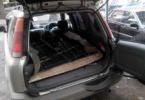When the factory tires are worn out or if you want to install new tires, the next question arises: which type of tire will fit perfectly? Each car make and model is designed for individual tread and wheel parameters. All the necessary information is contained in the technical documentation or on the body of the vehicle - on the lid of the petrol tank from the inside.
The online store of tires and disks "MOSSHINA" has developed a special online tire calculator, with the help of which it is possible to determine the differences between tires in percentages, inches and centimeters.
Visual tire calculator
It is imperative to find the correct rubber size. If you make a mistake and deviate from the factory standard sizes even by a few percent, the sensors will begin to distort the current information, fuel consumption will increase, and driving itself will become unsafe.
Tire calculator: tire comparison
With our electronic form, you can quickly and easily compare the circumference and diameter of a wheel, profile, tread. In addition, the tire calculator displays differences in suspension clearance, vehicle speed and engine RPM.
Tire calculator visual online: terms of use
In the upper left corner there are two forms for filling out:
- Previous size (standard size of the original tire);
- New size.
In the fields from left to right, you need to specify the tire width (millimeters), the height-to-width ratio (percent) and the rim diameter (inches). These figures are indicated on the tire profile. For convenience and clarity, an image of the tire and wheel is displayed, which can be turned on and off.
When filling in all the fields, the bus calculator will calculate the difference and provide all the information in the table on the right. If the difference is 3% or more, then we do not recommend installing such tires.
With the help of a tire calculator, you can easily calculate how the outer dimensions of the wheel, the height of the ground clearance (clearance), the speedometer readings and other characteristics will change when tires with a different standard size are installed on your car. The calculator calculates all tire sizes in millimeters, and the vehicle speed in km / h.
And also the calculator will help to calculate the required rim width for a specific tire size.
How to use the tire calculator:
First enter the standard size installed on your car, and then the one that you want to install and click "calculate". The table on the right shows the results of the calculator's calculations.
Detailed information on tire marking in the section: tire marking.
We recommend that you only install the factory tire sizes that are specified in the operating instructions for your machine. Installation of non-standard sizes may void the dealer's warranty, as well as impair the performance and handling of the vehicle.
Tire calculator for European tires
Old size:
New size:
145 155 165 175 185 195 205 215 225 235 245 255 265 275 285 295 305 315 325
/ 25 30 35 40 45 50 55 60 65 70 75 80 85
12 13 14 15 16 17 18 19 20 21 22 23 24
Found in the directory:
175/70 R13 -
175/70 R13 -
When converting tire sizes on a calculator, keep in mind that:
With an increase in the diameter of the rim (and, as a consequence, a decrease in the height of the tire profile, so that the outer diameter of the wheel remains unchanged), the load on the car's suspension increases, and comfort also deteriorates (the car will become noticeably stiffer).
With an excessive increase in the profile of the tire, the car becomes a "roll", it is less controlled and at critical values of the height of the profile, the tire can begin to cling to the parts of the body and suspension of the car, which will subsequently lead to its destruction.
Do you want to choose a tire for your car, but don't know much about tire labeling? It's not a problem! In this section, we will help you figure out: what are the parameters of the tire, what they mean, and what kind of tire is suitable for your car.
Find tires / tire catalogDecoding of tire marking.
195/65 R15 91 T XL
195 is the width of the tire in mm.
65 - Proportionality, i.e. the ratio of the height of the profile to the width. In our case, it is equal to 65%. Simply put, with the same width, the larger this figure, the higher the tire will be and vice versa. This value is usually referred to simply as “profile”.
Since the tire profile is a relative value, it is important to take into account when selecting tires that if instead of the 195/65 R15 standard size you want to put tires with the 205/65 R15 size, then not only the width of the tire will increase, but also the height! Which is unacceptable in most cases! (except for the cases when both of these standard sizes are indicated in the car manual). You can calculate the exact data on the change in the outer dimensions of the wheel in a special tire calculator.
If this ratio is not indicated (for example, 185 / R14C), then it is equal to 80-82% and the tire is called full-profile. Reinforced tires with such markings are usually used on vans and light trucks, where a high maximum wheel load is very important.
R- means a tire with a radial cord (in fact, now almost all tires are made this way).
Many people mistakenly think that R- stands for the radius of the tire, but this is precisely the radial design of the tire. There is also a diagonal design (denoted by the letter D), but recently it has practically not been produced, since its performance characteristics are noticeably worse.
15 - wheel (disk) diameter in inches. (It is the diameter, not the radius! This is also a common mistake). This is the "landing" diameter of the tire on the disc, i.e. it is the inner size of the tire or the outer one at the rim.
91 - load index. This is the maximum permissible load per wheel. For cars, it is usually done with a margin and when choosing tires is not a decisive value, (in our case, IN - 91 - 670 kg.). For vans and small trucks, this parameter is very important and must be observed.
Tire Load Index Table:

T- tire speed index. The larger it is, the more speed you can ride on this tire (in our case IS - N - up to 210 km / h). Speaking about the tire speed index, I would like to note that with this parameter the tire manufacturer guarantees the normal operation of the rubber with the constant movement of the car at the specified speed for several hours.
Speed Index Table:
American tire markings:
There are two different markings for American tires. The first one is very similar to the European one, only the letters "P" (Passanger - for a passenger car) or "LT" (Light Truck - light truck) are put in front of the standard size. For example: P 195/60 R 14 or LT 235/75 R15. And another marking of the tire, which is fundamentally different from the European one.
For instance: 31x10.5 R15(corresponds to European standard size 265/75 R15)
31
is the outer diameter of the tire in inches.
10.5
is the width of the tire in inches.
R- a tire of radial design (older models of tires were with a bias design).
15
is the inner diameter of the tire in inches.
Generally speaking, apart from the unusual inches, the American tire marking is logical and more understandable, unlike the European one, where the tire profile height is variable and depends on the tire width. And here everything is simple with the decoding: the first number of the standard size is the outer diameter, the second is the width, the third is the inner diameter.
Additional information indicated in the marking on the sidewall of the tire:
XL or Extra Load- a reinforced tire, the load index of which is 3 units higher than that of conventional tires of the same standard size. In other words, if a load index of 91 is indicated on a given tire, marked XL or Extra Load, then this means that with this index, the tire is capable of withstanding a maximum load of 670 kg instead of 615 kg (see the table of tire load indices).
M + S or M&S tire marking (Mud + Snow) - mud plus snow and means that the tires are all-season or winter. Many summer SUV tires are labeled M&S. However, these tires must not be used in winter because winter tires have a completely different rubber composition and tread pattern, and the M&S badge indicates a good cross-country performance of the tire.
All Season or AS all-season tires. Aw (Any Weather) - Any weather.
Pictogram * (snowflake)- rubber is intended for use in harsh winter conditions. If the sidewall of the tire does not have this mark, then this tire is intended for summer use only.
Aquatred, Aquacontact, Rain, Water, Aqua or pictogram (umbrella)- special rain tires.
Outside and Inside; asymmetrical tires, i.e. it is important not to confuse which side is external and which is internal. When installed, the Outside lettering should be on the outside of the car, and Inside on the inside.
RSC(RunFlat System Component) - RunFlat tires are tires on which you can continue driving a car at a speed of no more than 80 km / h with a FULL pressure drop in the tire (in the event of a puncture or cut). On these tires, depending on the manufacturer's recommendations, you can drive from 50 to 150 km. Different tire manufacturers use different designations for RSC technology. For example: Bridgestone RFT, Continental SSR, Goodyear RunOnFlat, Nokian Run Flat, Michelin ZP, etc.
Rotation or an arrow on the sidewall of the tire indicates a directional tire. When installing the tire, the direction of rotation of the wheel indicated by the arrow must be strictly observed.
Tubeless is a tubeless tire. In the absence of this inscription, the tire can only be used with a camera. Tube Type - means that this tire must be used only with a tube.
Max Pressure; maximum allowable tire pressure. Max Load - the maximum permissible load on each wheel of the vehicle, in kg.
Reinforced or the letters RF in the standard size (for example 195/70 R15RF) mean that this is a reinforced bus (6 layers). The letter C at the end of the dimension (eg 195/70 R15C) denotes a truck tire (8 layers).
Radial This marking on a rubber in a standard size means that it is a tire of a radial design. Steel means there is a metal cord in the tire construction.
Letter E(in a circle) - the tire complies with the European ECE (Economic Commission for Europe) requirements. DOT (Department of Transportation - US Department of Transportation) - American quality standard.
Temperature A, B or C heat resistance of tires at high speeds on a test bench (A is the best indicator).
Traction A, B or C- the ability of the tire to brake on a wet road surface.
Treadwear; the relative expected kilometers traveled versus the US specific standard test.
TWI (Tread Wear Indiration)- indicators of tire tread wear indicators. The TWI wheel can also be marked with an arrow. The gauges are evenly spaced at eight or six places around the tire circumference and indicate the minimum tread depth allowed. The wear indicator is made in the form of a protrusion with a height of 1.6 mm (the minimum tread size for light vehicles) and is located in the groove of the tread (usually in the drainage grooves).
DOT- Coded manufacturer address, tire size code, certificate, production date (week / year).
What is a tire calculator for:
With this tire calculator, you can easily calculate how the outer dimensions of the wheel, the height of the ground clearance (clearance), the speedometer readings and other characteristics will change when you install tires with a different standard size on your car.
Old tire size
Width
Height
Diameter
New tire size
Width
Select 5.0 5.5 6.0 6.5 7.0 7.5 8.5 9.5 10.5 11.5 12.0 12.5 13.0 13.5 14.5 125 135 145 155 165 175 185 195 205 215 225 235 245 255 265 275 285 295 305 315 325 335 345 355 365
Height
Select 25 27 30 31 32 33 34 35 38 38.5 40 45 50 55 60 65 70 75 80 85 90
Diameter
Select 12 13 14 15 16 16.5 17 17.5 18 19 20 21 22 23 24 25 26 28 30 32
First enter the standard size installed on your car, and then the one that you want to install.
The difference in speedometer readings and real speed depends on the speed of the car, the higher the speed, the greater the difference
| External dimensions | old | New | Difference | ||
|---|---|---|---|---|---|
| Tire width, mm (A) | 0 | 0 | 0 | ||
| Profile height, mm (B) | 0 | 0 | 0 | ||
| Disc diameter, mm (C) | 0 | 0 | 0 | ||
| Outside diameter, mm (D) | 0 | 0 | 0 | ||
| Change in ground clearance, mm | 0 |
On the website of the online store, the site contains a convenient tire calculator that allows you to easily calculate the changes in wheel parameters when switching to a different tire size. With this online tool, you can calculate the outer measurements of the wheel, ground clearance (ride height), calculate the speedometer readings and other characteristics.
With the onset of the new season, every responsible car owner considers it necessary to change the tires in accordance with the season. The best option would be to install tires of the size recommended by the automaker for a particular car brand. In cases where this is not possible, deviations in diameter in the 2% range are allowed.
Replacing rubber requires a serious approach. When choosing new tires and wheels, it is necessary to take into account such indicators as:
- tire width,
- profile height,
- inner diameter of the wheel,
- permissible speed indices.
Incorrectly selected tires can cause malfunctions in the car electronics, increase fuel consumption, deteriorate driving comfort, and also cause problems during a vehicle inspection at the traffic police.
How to calculate tires?
To find the correct tire size, you need to use a tire calculator, with which the theoretical dimensions are determined. All measurements are carried out in millimeters, and the speed in km / h. To make a calculation, you must enter the parameters of the tires of your car in the appropriate line. Then enter the dimensions of the new tire and the rim to be installed. After specifying all the parameters in the table below, information about changes in the width of the tire and the height of the profile, the inner and outer diameter, the difference in speed (real and according to the speedometer readings) will appear.
What to look for when choosing a tire
- Installing tires and wheels of non-standard sizes can damage the tire itself, damage the wheel and reduce the performance of the car. When choosing a rubber, it is better to rely on the recommendations of the automaker.
- If the diameter of the wheel rim is larger, then the load on the suspension may increase. To maintain the same diameter of the outer wheel, the profile height indicators should be reduced.
- If you choose tires with a greatly increased profile, you need to be prepared for a loss in the quality of vehicle handling. The tire can rub against the body and suspension, causing rapid wear.
- Even with the smallest difference between the indicators on the speedometer and in reality, the error can increase significantly with increasing speed, which makes driving unsafe.
- Narrow or too wide rims can deform the tire. This, in turn, will lead to premature wear and poor performance.
Instructions
Look at the nameplate in the driver's side doorway for the recommended tire size. Write it down on paper or memorize it. Find wheels of this size in a car dealer and use a tape measure to measure the outer diameter of the tire. Write this value down on paper. Drive the car into a hole and turn the front wheels out completely: first in one direction and then in the other direction. Measure with a ruler or tape measure the distance from the tire to the nearest structural member and write these values down on paper.
When choosing your favorite tires, consider the diameter of the future rims, and, depending on the size of the future tire, choose the width of the rims. The required disc width is equal to the tread width. It may be easier to find a disc with a slightly larger diameter and the desired width. For example, take rims of 14 inches instead of 13 and pick up tires on them. This option will be even more advantageous in terms of durability, but at the same time more expensive.
Try to buy tires that are approximately the same dimensions as the recommended ones. For example, the manufacturer recommends tires with dimensions 175 / 70R13 86S. 175 is the overall width of the tire in millimeters, / 70 is the height of the tire's profile as a percentage of the width, R-13 is the mounting diameter corresponding to the diameter of the discs, 86 is the load factor, S is the speed index. It is worth noting that the overall width of the tire may differ from the tread width, so if you want a wider tread, then pay attention to this feature. Do not use tires with reduced load and speed ratios.
If you want to put R16 wheels instead of R13 on your car, find a rubber of a suitable width. Since 175mm R16 tires do not exist, it is more realistic to find 215mm and wider tires. Look at your notes and calculate how many centimeters you have left. Increasing the tire width by 1cm more than the recommended one reduces the measured distance between the wheel and the body by 5mm. Please note that it is not advisable to increase the wheel diameter by more than 3 cm, as this will lead to increased fuel consumption and a deterioration in the traction characteristics of the machine. Select suitable tires and measure their diameter with a tape measure. Compare with the recommended wheel diameter. If the excess of the recommended dimensions of the future wheel is within the limits of your calculated norm, you can safely buy the selected tires. The speed and load factor in this case will significantly exceed the recommended one, which will have a beneficial effect on the durability of the rubber.



